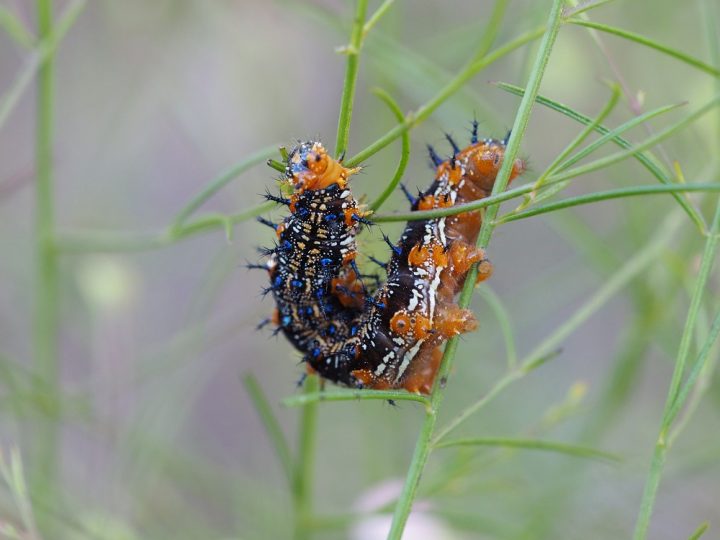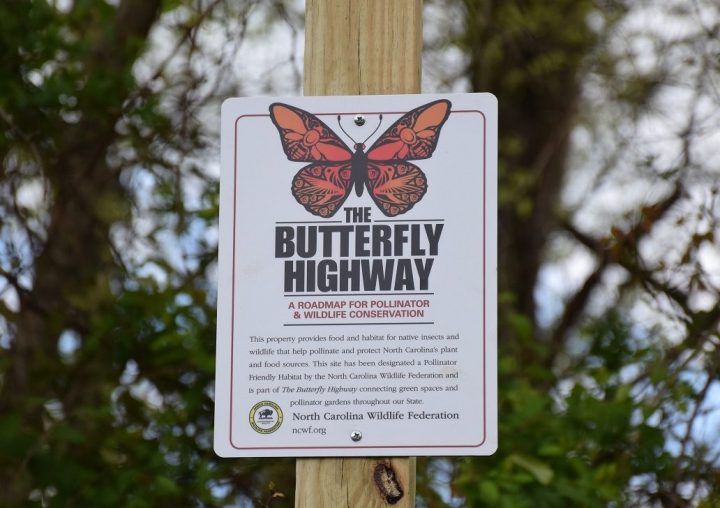First of two parts
While planning your spring garden, consider adding native plants and more diversity to make your yard a haven for pollinators and wildlife.
Supporter Spotlight
“As agriculture has intensified and our populations have grown, a lot of habitat has been lost, so even a pot of flowers on the front porch can make a big difference by supporting hundreds of pollinators,” said Nancy Lee Adamson, senior pollinator conservation specialist with the Xerces Society for Invertebrate Conservation and the U.S. Department of Agriculture’s Natural Resources Conservation Service in Greensboro.
The Xerces Society is a nonprofit invertebrate conservation organization. Invertebrates are animals without backbones such as insects, spiders, mollusks such as mussels and crustaceans like crabs.
If you’re adding plants with pollinators in mind, you’ll want to include a diversity of plants that bloom throughout the year, Adamson explained. “Ideally, include native wildflowers, shrubs, trees and even grasses. Native plants are best for butterflies and bees … but many other plants can benefit pollinators,” she said, adding that Xerces and other conservation organizations encourage avoiding invasive plants, a list of which can be found at the North Carolina Native Plant Society.
Pollinators are important because, besides pollinating 90 percent of wild plants and 75 percent of crops, “pollinators ensure the growth of plants that provide oxygen, clean water, materials for shelter, medicines, shade, reduce wind and noise, support the other wildlife we love to see like birds, mammals, amphibians, reptiles, and amphibians, either as food themselves or the seed, fruit, or structure provided by plants,” she said.
One way pollinators support other wildlife is by being a food source for hatchlings. Audubon North Carolina Field Organizer Kim Brand said that large native trees are ideal larval host plants for butterflies and moths, which baby land birds survive on.
Supporter Spotlight
“Caterpillars are the most important food for baby land birds. A nest full of chickadees needs more than 5,000 caterpillars just from hatching to the time they leave the nest,” Brand said. Large native trees such as oaks, hickories and pines are an excellent source of caterpillars because so many species of butterflies and moths lay eggs on them.

“For example, more than 500 species lay eggs on oak trees native to North America; for comparison, fewer than 10 species of native moths and caterpillars lay eggs on ginkgo leaves. The ginkgo is a food desert as far as caterpillars and parent birds are concerned,” she said. “We can also support a lot of caterpillars – and therefore feed the baby birds – with native perennials like goldenrods, asters, and joe-pye weed. All species that also feed adult pollinators, doing double-duty.”
Adamson recommends Doug Tallamy’s “Bringing Nature Home” and Sarah Stein’s “Noah’s Garden” as resources for understanding connections between native plants, native pollinators and other wildlife, including many birds. Xerces offers online plant lists and planting guides.
Edible plants or plants with fragrant leaves are pollinator plants that are also fun for kids.
“Strawberries, lavender, mint, parsley, dill, blackberries, black raspberries, onions, okra, squash, and passionfruit are all very easy to grow,” Adamson added. Just remember that caterpillars are butterfly larvae and eat the plants. The black swallowtail butterfly depends on parsley family plants, such as fennel and dill.
Eliminate Pesticides
Another simple way to provide habitat is to eliminate the use of pesticides, including herbicides, and leave unmown areas, dead trees or brush piles. Adamson recommended placing signs in your yard to help others understand that an unmown area or brush pile is intentional and help start a conversation about pollinator conservation.
“If no pesticides are used, the plants also support diverse predatory and parasitoid insects that eat the insects we consider pests, such as aphids and whiteflies. We might not think of ladybugs as pollinators, but they do some pollination, and depend on the same diverse flowers that bees and butterflies do, while their larvae are also voracious aphid and insect egg eaters,” she said.
An added benefit of using native pollinator plants is that the plants help protect soil. The roots and the microorganisms they support help water infiltrate deeper into the earth and reduce flooding.
“The plants not only help slow the movement of water, hold soil in place, and create deeper channels for water to reach underground, but the microorganisms that live in connection with the plants help clean the water,” Adamson explained. “Besides adding beauty to your landscape, native pollinator plants can also provide shelter from wind and shade.”
She recommends evergreens such as wax myrtle, inkberry holly, yaupon, sweet bay magnolia and eastern red cedar to support diverse pollinators, including one of her favorite butterflies, the juniper hairstreak butterfly.
“Many of our shade trees like red maple and black gum produce huge quantities of nectar and host diverse caterpillars. Even native grasses are vital, sheltering bumble bee nests when they lodge over, keeping the colony dry and out of site from predators like hawks.”
Proper Viewing
Adamson reminds you that if you get too close to bees, wasps or other insects on flowers, they will fly away.
“Only bees and wasps with colonies, like honey bees and yellow jackets, become defensive if you get too close to their nests, but not flowers. Most of our bees and wasps are solitary, “she said. “Unlike honey bees and yellow jackets that have colonies with a queen, young and food to protect, most bees and wasps are single moms, collecting food to place in a nest cell underground or in a cavity where she will lay an egg and never see her young hatch,” she said.
An example is the mud dauber wasp that collect spiders to lay eggs on. “Even though several tubes may be placed close together, single wasps are making each tube, so will either hide or fly away if you get too close. You can buy a wasp-deterrent paper lantern to keep yellow jackets from nesting near your door or paint your porch ceiling blue to keep them from nesting close to your house.”
She explained that if you place a bee observation box for solitary bees by your front door, “It is fun to watch them depositing pollen and nectar, laying an egg, then sealing the cells. Remember, your plantings stewardship can help support pollinators while also contributing to the well-being of your whole community,” she added.
“We just joined up with Bee City and Bee Campus USA a wonderful group that started in Asheville, NC www.beecityusa.org, so we hope to be able to support more urban greening work and fun art related efforts in future.”
Adamson pointed out that riparian areas and wetlands are especially important for pollinators. “During droughts they may be the only places where pollinators can find nectar and pollen producing plants. As urban areas grow, protecting riparian corridors is vital for pollinators and other wildlife, and can also help ensure green space for our own well-being. More and more research is highlighting the importance of green spaces on our health, cognitive abilities and creativity.”
Some folks think that pollinator gardens could cause allergies, but only wind-pollinated plants cause hay fever, she said. “Plants that require a pollinator have sticky, heavy pollen and are never listed in pollen counts, only wind-pollinated plants like oaks, pines, ragweed and grasses.”








